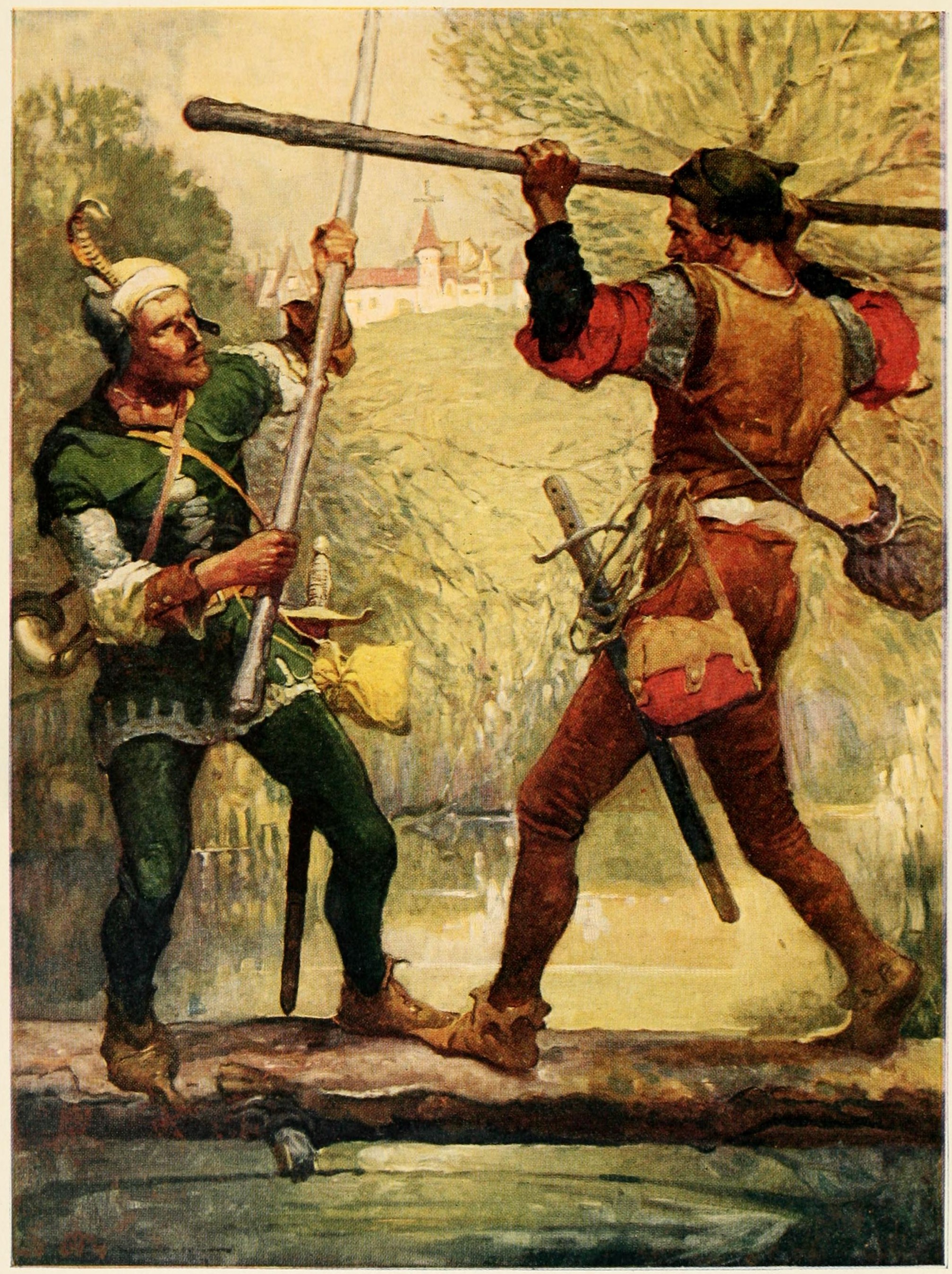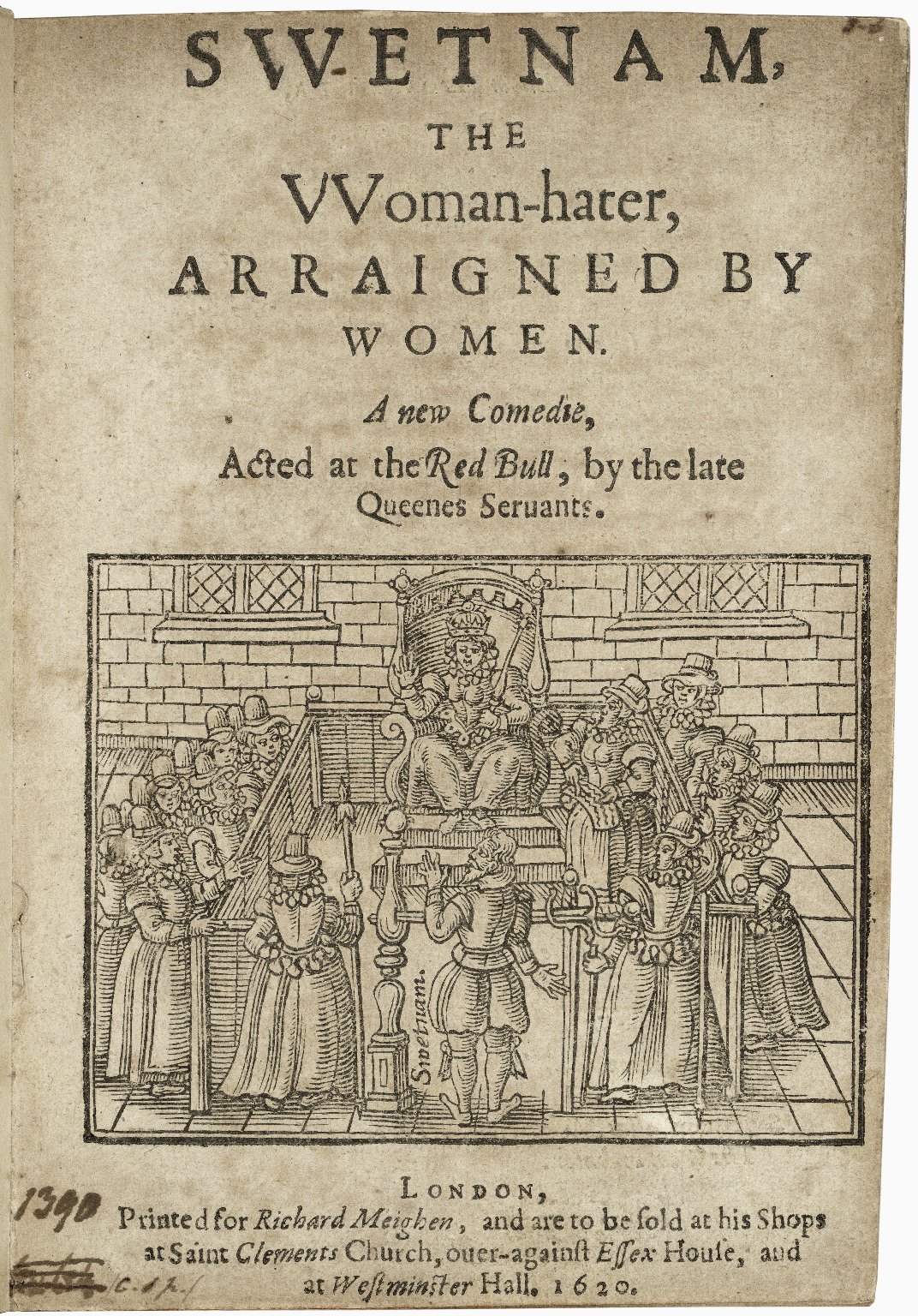|
Quarterstaff
A quarterstaff (plural quarterstaffs or quarterstaves), also short staff or simply staff is a traditional European pole weapon, which was especially prominent in England during the Early Modern period. The term is generally accepted to refer to a shaft of hardwood from long, sometimes with a metal tip, ferrule, or spike at one or both ends. The term "short staff" compares this to the "long staff" based on the pike with a length in excess of . The height of the staff should be around the same as the user plus their hand set upright on their head (approximately ). Etymology The name "quarterstaff" is first attested in the mid-16th century. The "quarter" possibly refers to the means of production, the staff being made from quartersawn hardwood (as opposed to a staff of lower quality made from conventionally sawn lumber or from a tree branch). OED; The possibility that the name derives from the way the staff is held, the right hand grasping it one-quarter of the distance from ... [...More Info...] [...Related Items...] OR: [Wikipedia] [Google] [Baidu] |
Robin Hood
Robin Hood is a legendary heroic outlaw originally depicted in English folklore and subsequently featured in literature and film. According to legend, he was a highly skilled archer and swordsman. In some versions of the legend, he is depicted as being of noble birth, and in modern retellings he is sometimes depicted as having fought in the Crusades before returning to England to find his lands taken by the Sheriff. In the oldest known versions he is instead a member of the yeoman class. Traditionally depicted dressed in Lincoln green, he is said to have robbed from the rich and given to the poor. Through retellings, additions, and variations, a body of familiar characters associated with Robin Hood has been created. These include his lover, Maid Marian, his band of outlaws, the Merry Men, and his chief opponent, the Sheriff of Nottingham. The Sheriff is often depicted as assisting Prince John in usurping the rightful but absent King Richard, to whom Robin Hood remai ... [...More Info...] [...Related Items...] OR: [Wikipedia] [Google] [Baidu] |
European Martial Arts
Historical European martial arts (HEMA) are martial arts of European origin, particularly using arts formerly practised, but having since died out or evolved into very different forms. While there is limited surviving documentation of the martial arts of classical antiquity (such as Greek wrestling or gladiatorial combat), surviving dedicated technical treatises or martial arts manuals date to the Late Middle Ages and the early modern period. For this reason, the focus of HEMA is ''de facto'' on the period of the half-millennium of ca. 1300 to 1800, with a German and an Italian school flowering in the Late Middle Ages and the Renaissance (14th to 16th centuries), followed by Spanish, Portuguese, French, English, and Scottish schools of fencing in the modern period (17th and 18th centuries). Arts of the 19th century such as classical fencing, and even early hybrid styles such as Bartitsu, may also be included in the term HEMA in a wider sense, as may traditional or folklorist ... [...More Info...] [...Related Items...] OR: [Wikipedia] [Google] [Baidu] |
Prize Playing
A Prize Playing was a test of martial skill popular in Renaissance England with the London-based Corporation of Masters of the Noble Science of Defence. It involved several dozen bouts against continually refreshing opponents, with little or no rest in between. This practice was revived after a fashion in the late 17th century in the form of "Prize Fights", whence the term prizefighting for modern professional boxing. Renaissance Prize Playings The time and place for a Prize Playing was determined by the four Ancient Masters of the school. Notices called Bills of Challenge were posted of the event and a wooden scaffolding was erected in a public square. A good number of formalities were observed and at one time rules were endorsed by the Crown. On the appointed day and time, following a procession of drums and flags the Player was paraded to the raised scaffold with much fanfare. The public gathered close to watch, cheer, and throw coins onto the platform; the student would e ... [...More Info...] [...Related Items...] OR: [Wikipedia] [Google] [Baidu] |
Stick Fighting
Stick-fighting, stickfighting, or stick fighting is a variety of martial arts which use simple long, slender, blunt, hand-held, generally wooden "sticks" for fighting, such as a gun staff, bō, jō, walking stick, baston, arnis sticks or similar weapons. Some techniques can also be used with a sturdy umbrella or even with a sword or dagger in its scabbard. Thicker and/or heavier blunt weapons such as clubs or the mace are outside the scope of "stick-fighting" (since they cannot be wielded with such precision, so sheer force of impact is more important), as are more formed weapons such as the '' taiaha'' used by the Māori people of New Zealand, and the '' macuahuitl'' used by the Aztec people of Mesoamerica in warfare. Although many systems are defensive combat techniques intended for use if attacked while lightly armed, others such as ''kendo'', ''arnis'', and ''gatka'' were developed as safe training methods for dangerous weapons. Whatever their history, many stick-fighting ... [...More Info...] [...Related Items...] OR: [Wikipedia] [Google] [Baidu] |
Joseph Swetnam
Joseph Swetnam (died 1621) was an English pamphleteer and fencing master. He is best known for a misogynistic pamphlet and an early English fencing treatise. Three defensive responses as pamphlets were made by Rachel Speght, Ester Sowernam and Constantia Munda. The Pamphlet Wars Swetnam's pamphlet attacking women was one of the most influential of the era. ''The Arraignment of Women'' (1615) ''The arraignment of lewd, idle, froward, and unconstant women'' was published in 1615 under the pseudonym Thomas Tell-Troth. Despite this attempt at anonymity, Swetnam was quickly known as the true author. (The full title of the original pamphlet was: ) Swetnam describes in this document what he views as the sinful, deceiving, worthless nature of women. He addresses his remarks to young men of the world, as if warning them about the dangers of womankind. He cites personal experiences as well as those of well-known biblical and classical figures to authenticate his claims. Obviou ... [...More Info...] [...Related Items...] OR: [Wikipedia] [Google] [Baidu] |
Company Of Masters
The Company of Maisters of the Science of Defence was an organisation formed in England during the reign of Henry VIII to regulate the teaching of the ''Arte of Defence'' or ''fencing'', using a range of weapons, including the rapier, quarterstaff, and, most notably, the broadsword. This school of fencing persisted throughout the 16th century but declined after the end of the Tudor period. Tudor England It served to prevent unlicensed instructors from operating, both as a form of quality assurance and as a monopoly to protect the livelihoods of its members. It also regulated the conduct of members to one another, both instructor and student. Like the guilds it resembled, the company certified its members with varying ranks, depending on their level of skill and degree of permission to teach. Beginning students took the title ''Scholar'' and were required to hold the rank for no less than seven years before progressing to a higher rank following the passing of a test known as P ... [...More Info...] [...Related Items...] OR: [Wikipedia] [Google] [Baidu] |
Boy Scout
A Scout (in some countries a Boy Scout, Girl Scout, or Pathfinder) is a child, usually 10–18 years of age, participating in the worldwide Scouting movement. Because of the large age and development span, many Scouting associations have split this age group into a junior and a senior section. Scouts are organized into troops averaging 20–30 Scouts under the guidance of one or more Scout Leaders or Scoutmasters. Troops subdivide into patrols of about 6–8 Scouts and engage in outdoor and special interest activities. Troops may affiliate with local, national, and international organizations. Some national Scouting associations have special interest programs such as Air Scouts, Sea Scouts, outdoor high adventure, Scouting bands, and rider Scouts. Foundation After the Second Boer War boys showed considerable interest in ''Aids to Scouting'', a book about military scouting and wilderness survival written by a hero from that war, Robert Baden-Powell. The book was also use ... [...More Info...] [...Related Items...] OR: [Wikipedia] [Google] [Baidu] |
Medieval Polearms
In the history of Europe, the Middle Ages or medieval period lasted approximately from the late 5th to the late 15th centuries, similar to the post-classical period of global history. It began with the fall of the Western Roman Empire and transitioned into the Renaissance and the Age of Discovery. The Middle Ages is the middle period of the three traditional divisions of Western history: classical antiquity, the medieval period, and the modern period. The medieval period is itself subdivided into the Early, High, and Late Middle Ages. Population decline, counterurbanisation, the collapse of centralized authority, invasions, and mass migrations of tribes, which had begun in late antiquity, continued into the Early Middle Ages. The large-scale movements of the Migration Period, including various Germanic peoples, formed new kingdoms in what remained of the Western Roman Empire. In the 7th century, North Africa and the Middle East—most recently part of the Eastern Roman ... [...More Info...] [...Related Items...] OR: [Wikipedia] [Google] [Baidu] |
Rowland Allanson-Winn, 5th Baron Headley
Rowland George Allanson Allanson-Winn, 5th Baron Headley (19 January 1855 – 22 June 1935), also known as Shaikh Rahmatullah al-Farooq, was an Irish peer and a prominent convert to Islam, who was also one of the leading members of the Woking Muslim Mission alongside Khwaja Kamal-ud-Din. He also presided over the British Muslim Society for some time. Biography image:Lord Headley with Khwaja Kamal-ud-Din.jpg, 140px, left, Lord Headley with Khwaja Kamal-ud-Din Rowland George Allanson Allanson-Winn was born in London and educated at Westminster School and Trinity College, Cambridge, Trinity College, Cambridge University. He then entered Middle Temple, before commencing studies at King's College London. He subsequently became a civil engineer by profession, a builder of roads in India, and an authority on the protection of intertidal zones. He was an enthusiastic practitioner of boxing as well as other arts of self-defence, and in 1890 co-authored, with C. Phillipps-Wolley, th ... [...More Info...] [...Related Items...] OR: [Wikipedia] [Google] [Baidu] |
Johannes Liechtenauer
Johannes Liechtenauer (also ''Lichtnauer'', ''Hans Lichtenawer'') was a German fencing master who had a great level of influence on the German fencing tradition in the 14th century. Biography Liechtenauer seems to have been active during the mid-to-late 14th century. The only extant biographical note on Liechtenauer is found in GNM Hs. 3227a (dated c. 1400), which states that "Master Liechtenauer learnt and mastered he art of the swordin a thorough and rightful way, but he did not invent it or make it up himself, as it is stated before. Instead, he travelled across and visited many lands for the sake of this rightful and true art, as he wanted to study and know it." His surname indicates he was from a place called ''Liechtenau'' (modern ''Lichtenau''). There are several places with this name. Massmann (1844) mentions five candidate locations: Lichtenau im Mühlkreis in Upper Austria; Lichtenau in Franconia, Nuremberg; Lichtenau on the Rhine, Baden, near Strasbourg; Lichte ... [...More Info...] [...Related Items...] OR: [Wikipedia] [Google] [Baidu] |
Robin Hood And The Tinker
Robin Hood and the Tinker is Child Ballad 127. Synopsis Robin Hood meets with a tinker and tells him that two tinkers were put in the stocks for drinking ale and beer. The tinker tells him that he has a warrant for Robin Hood in his pouch. Robin tells him to come with him to Nottingham. They stop at an inn to drink. When the tinker is drunk, Robin takes the warrant and his money and leaves the tinker with the bill. The host tells him that the man he drank with was Robin Hood. The tinker starts tracking him down and fights with him, but when he is winning, he lets Robin blow on his horn. This summons Robin's men and ends the fight. Robin offers him a hundred pounds to join the band. Adaptions Howard Pyle Howard Pyle (March 5, 1853 – November 9, 1911) was an American illustrator and author, primarily of books for young people. He was a native of Wilmington, Delaware, and he spent the last year of his life in Florence, Italy. In 1894, he began ... included this story ... [...More Info...] [...Related Items...] OR: [Wikipedia] [Google] [Baidu] |
Lunge (fencing)
The lunge is the fundamental footwork technique used with all three fencing weapons: foil, épée and sabre. It is common to all contemporary fencing styles. The lunge is executed by kicking forward with the front foot, and pushing the body forward with the back leg. It can be used in combination with different blade work to deliver an offensive action such as an attack. The lunge is one of the most basic and most common types offensive footwork. Relation to the attack The lunge is often used to deliver an attack. In sabre, the end of the attack is defined by the front foot of the lunge landing on the piste. An attack can be made with a lunge on its own, or can be made with a step-forward-lunge, which are both considered single tempo actions. History The characteristic motion of the modern lunge traces its ancestry to European swordplay of the 16th and 17th centuries. Scholars of fence such as Egerton Castle attribute the first true lunging attack to Angelo Viggiani and ... [...More Info...] [...Related Items...] OR: [Wikipedia] [Google] [Baidu] |


_1r.jpg)






